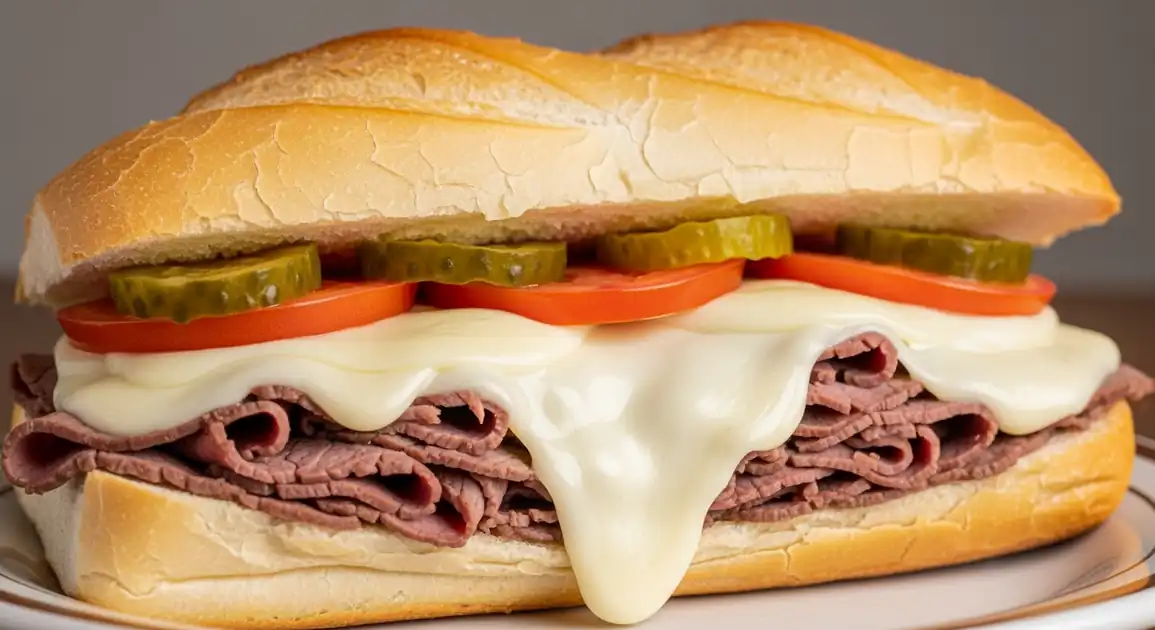Bauru Paulista (Sandwich)
Bauru Paulista

Description
The Bauru sandwich, especially its common ham-and-cheese variation, is found in 'lanchonetes' and 'padarias' throughout Brazil. However, the traditional 'Bauru Paulista' with roast beef, adhering closer to the original recipe, is more strongly associated with São Paulo state.
Dietary Information
Serving information
Serving style
Served warm, usually sliced in half diagonally. Often eaten by hand, even if served on a plate. In some 'padarias', it might be served wrapped in paper to go.
Quick facts
Lanchonetes and Padarias often open early (6 AM or 7 AM) and close late (8 PM or much later), especially lanchonetes.
Safety Tips
What to Look For
-
Sandwich assembled and heated fresh to order
Ensures ingredients haven't been sitting out and that the sandwich is heated thoroughly, especially the meat and cheese.
-
Cheese is fully melted and hot
Proper heating is crucial for safety and taste. The cheese should be visibly melted and gooey.
-
Fresh-looking ingredients (roast beef, tomato)
Roast beef should look moist and properly preserved. Tomatoes should be fresh and vibrant. Avoid wilted or discolored ingredients.
-
Clean preparation area and utensils
Observe the cleanliness of the grill/press, cutting boards, knives, and the vendor's hygiene practices.
-
Busy establishment with high turnover
Suggests ingredients are likely fresh due to frequent replenishment.
What to avoid
-
Pre-assembled sandwiches sitting at room temperature
Increases risk of bacterial growth, especially with meat and cheese. Insist on fresh preparation.
-
Meat or cheese that looks old, dry, or discolored
Indicates poor quality and potential spoilage.
-
Sandwich served lukewarm or cold
Suggests improper heating, which is a food safety concern for meat and cheese sandwiches.
-
Visibly dirty grill, press, or preparation surfaces
Poor hygiene significantly increases the risk of cross-contamination.
Price information
Price range
Budget tips
- Prices are generally lower in neighborhood 'padarias' and 'lanchonetes'.
- The ham version is usually cheaper than the roast beef version.
- University canteens often offer budget-friendly Bauru options.
Value indicators
- Generous amount of roast beef (if original).
- Properly melted cheese.
- Fresh bread and vegetables.
- Made fresh to order.
Where to Find This Dish
Lanchonetes
Ubiquitous snack bars found on almost every commercial street.
Look for signs saying 'Lanches' or specific names
Lunch, Afternoon, Evening
Padarias
Neighborhood bakeries, often with a deli counter or seating area.
Identifiable by 'Padaria' signs
Morning (for bread), Lunch, Afternoon
Shopping Mall Food Courts
Many food courts have stalls selling various Brazilian sandwiches, including Bauru.
Major shopping centers
Lunch, Dinner
Vendor Tips
- Specify 'Bauru com rosbife' if you want the roast beef version. Otherwise, you might get ham.
- Ask for 'sem miolo' if you want the bread hollowed out in the traditional style (less common now).
- Observe the freshness of the roast beef if possible before ordering.
How to Order
Regional Variations
-
Bauru with Ham
(Bauru com Presunto)
The most common variation, substituting ham for roast beef. Often simply called 'Bauru' without the 'Paulista' distinction.
-
Bauru with different cheeses
(Bauru com outros queijos)
While mozzarella is traditional, some places might use 'queijo prato' (a common Brazilian cheese) or other types.
-
'Bauru Americano'
(Bauru Americano)
A variation that typically includes ham, cheese, lettuce, tomato, and sometimes a fried egg, deviating significantly from the original.
-
Added ingredients
(Ingredientes adicionais)
Some places might add mayonnaise, oregano, lettuce, or other ingredients not found in the classic recipe.
Cultural context
History
The Bauru sandwich boasts a specific origin story. In 1934, Casimiro Pinto Neto, a law student from the town of Bauru frequenting the Ponto Chic bar in São Paulo, dictated a custom sandwich recipe to the cook. It included French bread hollowed out, roast beef, mozzarella melted in a bain-marie, tomato, and pickled cucumber. The creation was overheard, replicated, and quickly became famous, named after the student's hometown. Ponto Chic still serves the 'Original Bauru' today.
Local significance
A classic Brazilian sandwich, representing the 'lanche' (snack/light meal) culture. The original Bauru is a point of pride for São Paulo.
Eating customs
- Typically eaten by hand.
- Often accompanied by a fresh fruit juice ('suco') or soda ('refrigerante').